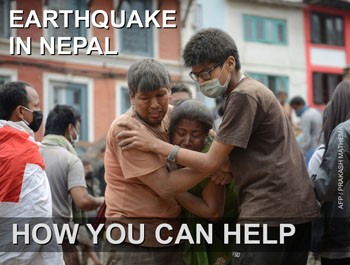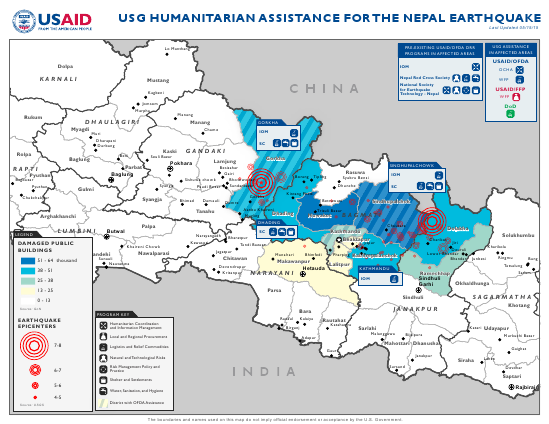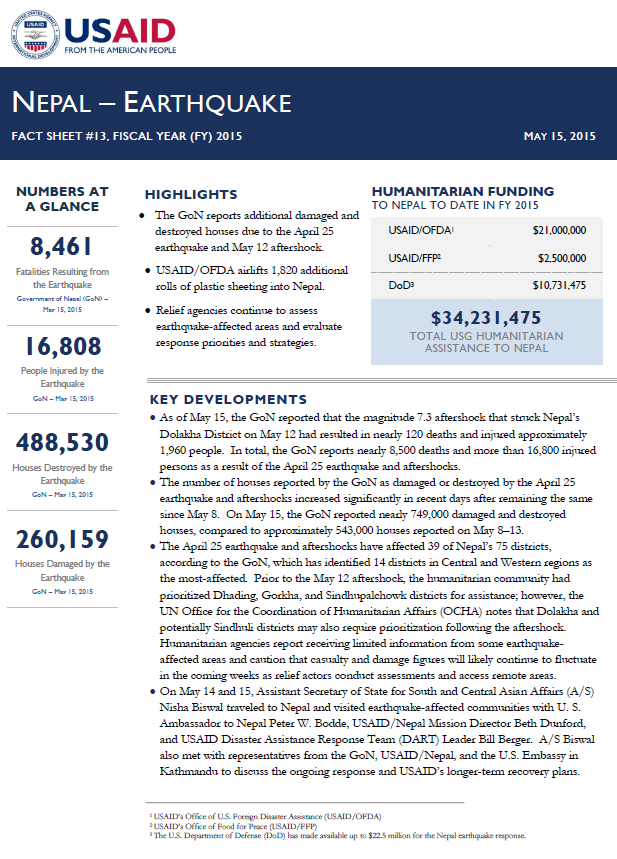Speeches Shim
May 15, 2015
Highlights
The GoN reports additional damaged and destroyed houses due to the April 25 earthquake and May 12 aftershock.
USAID/OFDA airlifts 1,820 additional rolls of plastic sheeting into Nepal.
Relief agencies continue to assess earthquake-affected areas and evaluate response priorities and strategies.
Key Developments
As of May 15, the GoN reported that the magnitude 7.3 aftershock that struck Nepal’s Dolakha District on May 12 had resulted in nearly 120 deaths and injured approximately 1,960 people. In total, the GoN reports nearly 8,500 deaths and more than 16,800 injured persons as a result of the April 25 earthquake and aftershocks.
Nepal Earthquake Map - May 15, 2015 ![]() (pdf - 989k)
(pdf - 989k)
Numbers At A Glance
8,461
16,808
488,530
260,159
Humanitarian Funding:
To Nepal To Date In FY2015:
| USAID/OFDA | $21,000,000 |
| USAID/FFP | $2,500,000 |
| DoD | $10,731,475 |
| TOTAL | $34,231,475 |
Nepal Earthquake Fact Sheet #13 - 05-15-2015 ![]() (pdf - 192k)
(pdf - 192k)
The number of houses reported by the GoN as damaged or destroyed by the April 25 earthquake and aftershocks increased significantly in recent days after remaining the same since May 8. On May 15, the GoN reported nearly 749,000 damaged and destroyed houses, compared to approximately 543,000 houses reported on May 8–13.
The April 25 earthquake and aftershocks have affected 39 of Nepal’s 75 districts, according to the GoN, which has identified 14 districts in Central and Western regions as the most-affected. Prior to the May 12 aftershock, the humanitarian community had prioritized Dhading, Gorkha, and Sindhupalchowk districts for assistance; however, the UN Office for the Coordination of Humanitarian Affairs (OCHA) notes that Dolakha and potentially Sindhuli districts may also require prioritization following the aftershock. Humanitarian agencies report receiving limited information from some earthquake-affected areas and caution that casualty and damage figures will likely continue to fluctuate in the coming weeks as relief actors conduct assessments and access remote areas.
On May 14 and 15, Assistant Secretary of State for South and Central Asian Affairs (A/S) Nisha Biswal traveled to Nepal and visited earthquake-affected communities with U. S. Ambassador to Nepal Peter W. Bodde, USAID/Nepal Mission Director Beth Dunford, and USAID Disaster Assistance Response Team (DART) Leader Bill Berger. A/S Biswal also met with representatives from the GoN, USAID/Nepal, and the U.S. Embassy in Kathmandu to discuss the ongoing response and USAID’s longer-term recovery plans.
HUMANITARIAN ASSESSMENTS
On May 13, the Agency for Technical Cooperation and Development (ACTED) conducted rapid needs assessments in five earthquake-affected village development committees (VDCs), including Alambu, Charikot, Sundrawati, Sunkhani, and Suspa Kshyamawati, in Dolakha—the site of the May 12 aftershock. ACTED reported that the initial earthquake and aftershock rendered between 95 and 100 percent of houses in the five VDCs uninhabitable and damaged or destroyed much of the community infrastructure, including water systems and latrines. Health centers in the assessed areas also sustained significant damage, and landslides have decreased access to health services in other areas. While all but one of the VDCs confirmed receiving at least minimal assistance from the GoN or non-government organizations (NGOs) following the April 25 earthquake, none of the communities in the assessed locations reported receiving assistance following the May 12 aftershock. ACTED delivered shelter supplies to some of the affected communities and plans to provide additional relief items in the coming days.
On May 14, DART field officers and a DART water, sanitation, and hygiene (WASH) advisor visited communities in Nuwakot and Rasuwa—two of the most-affected districts—and observed significant damage to houses in the areas visited. Residents are salvaging materials from damaged and collapsed structures and purchasing corrugated iron to construct temporary and transitional shelters for use until monsoon season concludes in September, according to the DART. While in Nuwakot, DART staff met with relief agencies that noted humanitarian coordination issues in the district, including a lack of direction from local authorities.
HUMANITARIAN ACCESS
Relief agencies, including USAID/OFDA partner the International Organization for Migration (IOM), continue to report difficulty accessing some earthquake-affected populations due to poor weather, difficult terrain, damaged infrastructure, and ongoing aftershocks and landslides. According to IOM, approximately 315,000 people in 10 of the 14 most-affected districts are not accessible by road, and an estimated 75,000 people are not accessible by air. As the humanitarian community focuses on reaching people in remote areas, OCHA notes that some communities in accessible areas are also reportedly not receiving sufficient assistance.
Landslides triggered by aftershocks and pre-monsoon rains are hampering relief efforts in many affected districts, and the impending monsoon season will likely lead to additional access constraints, as well as increased humanitarian needs. Relief agencies continue to emphasize the need for rapidly providing shelter assistance and relief supplies in advance of the monsoon rains.
USAID/OFDA partners and other humanitarian organizations are coordinating with the GoN to identify solutions to access challenges and reach populations in need of assistance. U.S. military aircraft continue to supplement GoN and international response efforts by transporting humanitarian personnel and critical relief items, such as emergency shelter materials, to difficult-to-access areas.
SHELTER AND DISPLACEMENT
On May 14, the number of houses reported as destroyed by the GoN increased by 66 percent from the number reported daily since May 8. The number increased again on May 15 and currently totals approximately 488,500 houses. Additionally, the number of houses reported as damaged—currently more than 260,000—increased by more than 6,000 houses between May 8 and 15. The increased figures may include some houses affected by the April 25 earthquake that were not yet reported, as well as new damage from the May 12 aftershock. Relief organizations report requiring additional assessment data to fully understand the shelter needs and response gaps.
Prior to the May 12 aftershock, the Shelter Cluster—the coordinating body for humanitarian shelter activities, comprising UN agencies, NGOs, and other stakeholders—planned to target 350,000 households with shelter support; however, the cluster is currently revising its targets and exploring options, such as cash-based assistance, to more effectively meet the increased needs.
On May 14 and 15, three shipments containing 1,820 rolls of USAID/OFDA-procured plastic sheeting arrived at the airport in Nepal’s capital city, Kathmandu. To date, USAID/OFDA has airlifted 2,520 rolls of plastic sheeting to provide temporary shelter assistance for up to 126,000 earthquake-affected people.
AGRICULTURE AND FOOD SECURITY
As of May 13, the GoN reported that the April 25 earthquake had damaged or destroyed more than 543,000 houses, not including houses damaged or destroyed by the May 12 aftershock. Relief agencies expect areas affected by the May 12 aftershock to require reassessment in the coming days, and OCHA anticipates an increase in the number of households requiring shelter materials and other relief commodities.
To date, cluster partners have distributed more than 134,400 tarpaulins, 7,800 tents, 16,400 household kits, and 19,600 blankets to earthquake-affected populations, according to OCHA. An estimated 500,000 additional tarpaulins are currently en route to Nepal, OCHA reports.
HUMANITARIAN COORDINATION AND INTERNATIONAL ASSISTANCE
During a recent inter-cluster coordination meeting, cluster partners discussed issuing a revised flash appeal in late May. The updated appeal would allow cluster partners to take stock of the response to date, including ongoing humanitarian assessments and early recovery efforts, and redefine response strategies as necessary.
To date, the USG has provided more than $34 million for earthquake response and recovery efforts in Nepal. The funding is supporting urgent shelter and WASH needs, as well as humanitarian coordination, logistics, and the distribution of relief commodities. As of May 15, other international donors had provided more than $156 in humanitarian assistance for Nepal, including nearly $66.3 million towards Nepal’s $423 million flash appeal.
CONTEXT
On April 25, a magnitude 7.8 earthquake struck central Nepal at a shallow depth of approximately 15 kilometers (km), according to the USGS. The epicenter of the earthquake was located approximately 77 km northwest of Kathmandu, the country’s capital city, and 73 km east of Pokhara, another major city in central Nepal.
The USG immediately issued a disaster declaration for Nepal due to the effects of the earthquake. Within hours of the seismic event, USAID/OFDA had activated a RMT in Washington, D.C., and deployed a DART—including USAR specialists—to support emergency response efforts in Nepal.
For nearly two decades, USAID/OFDA has supported disaster risk reduction (DRR) efforts in Nepal, including throughout Kathmandu Valley. USAID/OFDA funding has enabled the International Organization for Migration (IOM) to identify, prepare, and preserve more than 80 open spaces in Kathmandu Valley to ensure the sites are available for humanitarian purposes—such as distribution centers or warehouses—in the event of large-scale disasters. USAID/OFDA has also supported NRCS to pre-position critical emergency relief supplies in order to address the immediate needs of affected communities following a disaster.
Through the Kathmandu-based National Society for Earthquake Technology (NSET), USAID/OFDA is strengthening Nepal’s earthquake response capacity by institutionalizing DRR at the local and national levels in collaboration with the GoN, non-governmental organizations, schools, and local communities. With USAID/OFDA support, NSET is also promoting public-private partnerships for earthquake risk management and enhancing the capacity of municipal governments to develop and administer building code permits and control systems to better protect against seismic activity.
PUBLIC DONATION INFORMATION
The most effective way people can assist relief efforts is by making cash contributions to humanitarian organizations that are conducting relief operations. A list of humanitarian organizations that are accepting cash donations for disaster responses around the world can be found at www.interaction.org.
USAID encourages cash donations because they allow aid professionals to procure the exact items needed (often in the affected region); reduce the burden on scarce resources (such as transportation routes, staff time, and warehouse space); can be transferred very quickly and without transportation costs; support the economy of the disaster-stricken region; and ensure culturally, dietary, and environmentally appropriate assistance.
More information can be found at:
- The Center for International Disaster Information: www.cidi.org or +1.202.821.1999.
-
Information on relief activities of the humanitarian community can be found at www.reliefweb.int.




Comment
Make a general inquiry or suggest an improvement.